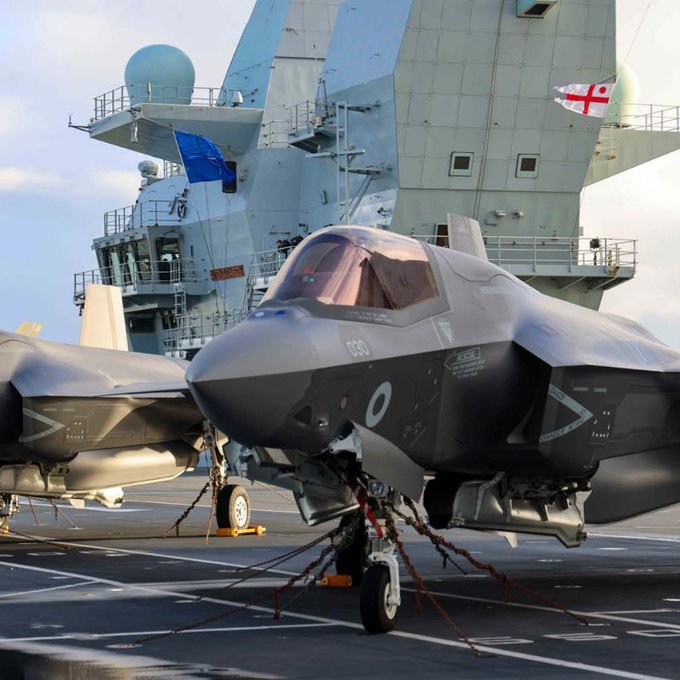The HMS Queen Elizabeth, the Royal Navy’s and United Kingdom’s mightiest flagship vessel, has come under the command of NATO for the first time, standing as a formidable force to protect the alliance’s frontiers.
NATO announced this development on X (formerly Twitter), spotlighting the deployment of the British aircraft carrier alongside allied forces for the Neptune Strike exercise.
NATO tweeted, “HMS Queen Elizabeth, @RoyalNavy’s largest and most powerful ship ever built, sails under NATO command for the first time. The UK aircraft carrier & carrier strike group is deployed alongside Allies for Neptune Strike, demonstrating NATO’s ability to protect and defend against any threat.”
In a statement, the Royal Navy announced the transfer of control for HMS Queen Elizabeth and the UK Carrier Strike Group (UKCSG) to NATO.
This formidable task group includes the frigate HMS Kent, destroyer HMS Diamond, aircraft such as F-35B Lightning jets, Wildcat, Merlin helicopters, and support ships. The shift to NATO command aims to create a task group capable of operating across a vast area, ranging from the Mediterranean to the Baltic Sea.
HMS Queen Elizabeth, @RoyalNavy’s largest and most powerful ship ever built, sails under NATO command for the first time.
The 🇬🇧 aircraft carrier & carrier strike group is deployed alongside Allies for #NeptuneStrike, demonstrating NATO’s ability to protect and defend against… pic.twitter.com/8FXBOc8OCm
— NATO (@NATO) November 9, 2023
Under NATO’s command, three aircraft carriers have been strategically deployed, including the UKCSG in the North Sea, the Italian ITS Cavour, and the Spanish ESP Juan Carlos in the Mediterranean.
According to the Royal Navy, this collaboration knits together cutting-edge forces, ensuring readiness to defend every inch of the alliance’s airspace, waterways, and territory.
The ongoing exercise, codenamed Neptune Strike, involves warships from 21 nations. These forces operate under the command and control of NATO’s Naval and Striking Support Forces, a battle staff under the Supreme Allied Commander Europe, entrusted with rapidly planning and executing operations wherever needed.
Neptune Strike is characterized as an ‘enhanced vigilance activity,’ reaffirming NATO’s enduring strength and relevance. This demonstration underscores NATO’s commitment to fulfilling its defensive obligations as an alliance.

When a Royal Navy ship and its crew operate under NATO command, they undertake duties crucial to the alliance for a predetermined period, demonstrating the nation’s unwavering commitment to the security of its allies and partners.
Upon completion of the operation or in response to UK requirements, the ships revert to Royal Navy control for subsequent tasking.
Commodore James Blackmore, Commander of the UK’s Carrier Strike Group, said, “Deterrence and defense of the Euro Atlantic is at the heart of NATO, and our enhanced vigilance activity with Neptune Strike clearly demonstrates that.
“This is the first time NATO has commanded a UK Carrier Strike Group in my memory, so this is noteworthy for the UK and the alliance. I look forward to a full week of activity and much more in the future; we are stronger together,” Blackmore added.
NEPTUNE STRIKE 2023-3
Commencing on October 30 and scheduled until November 10, Naval Striking and Support Forces NATO (STRIKFORNATO) launched the NATO-led enhanced Vigilance Activity Neptune Strike 23-3.
The Allied nations underscore the commitment of the NATO Alliance to sovereignty and freedom. This marks the third iteration of Neptune Strike in 2023, a tangible demonstration of NATO’s unwavering strength and relevance.
According to NATO, the Neptune Strike series is a concrete manifestation of the NATO Alliance’s power and capability in multi-domain operations.
It highlights NATO’s evolving proficiency in integrating high-end maritime warfare capabilities from carrier strike groups, thereby supporting the defense of the Alliance through the execution of enhanced Vigilance Activities (eVAs).
In the ongoing Neptune Strike exercise, HMS Queen Elizabeth engaged in a simulated cat-and-mouse scenario with a Norwegian submarine in the North Sea, as reported by the Royal Navy.

Norwegian submarine HNoMS Utstein, tasked with the mission to ‘sink’ the aircraft carrier, encountered resistance from the submarine-hunting Merlin helicopters of the 820 Naval Air Squadron.
The exercise served as a rigorous test of naval aviators’ skills and tactical decision-making, incorporating the collaboration of a long-range Royal Air Force P8 Poseidon maritime patrol aircraft in the hunt for the Ula-class submarine.
During the exercise, the Merlins utilized sonobuoys, often called ‘underwater ears,’ to locate the submarine beneath the surface.
In an earlier deployment phase, the Merlins executed a rare ‘fin transfer,’ deftly hovering over Utstein on the water’s surface to facilitate the movement of supplies and personnel.
This training also highlights the proficiency of the Merlin aircrew in executing complex maneuvers. It ensures their preparedness for the intricate process of evacuating casualties from a submarine during patrol missions.
- Contact the author at ashishmichel(at)gmail.com
- Follow EurAsian Times on Google News




